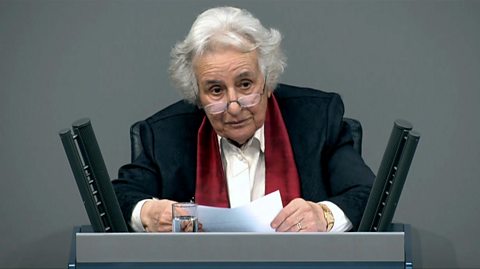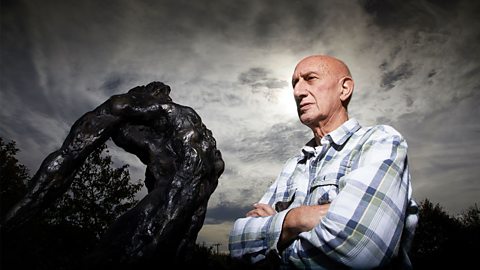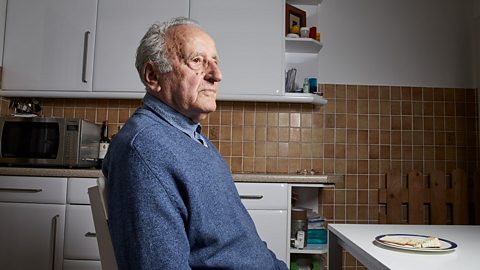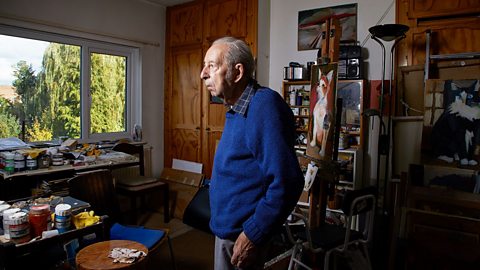FRANK BRIGHT:We start in May 1942, thatβs when the class picture was probably taken. Thatβs me.
INTERVIEWER:What do you call this picture?
FRANK BRIGHT:I call it red for dead, which is pretty crude but itβs to the point. Itβs known as that.
INTERVIEWER:What did you hope to achieve for searching the fates of your old classmates?
FRANK BRIGHT:Well since I had the means and the energy to do it, I felt I ought to bring them back into memory. Otherwise like all the rest they disappeared in oblivion.
What I did was I took this photo, I put numbers against each child, and if you take number one, that was Pick Hanus, he was born on the 21st of January 1929, his last address was Prague II, Vladislavova 19, he went to the ghetto on transport Cc, his transport number was 453 on the 20th, 11, 1942, he was sent on from the ghetto, he was sent to Auschwitz, he did not survive, and that of his transport of 2038 people, 144 survived.
Take number 24, she had ginger hair as far as I remember. Lunge, Susannah Lunge, sent to Auschwitz in October 1944, did not survive. Number 9 Cora Seditor very pretty girl, I think I had a crush on her but from a distance. Was sent to Auschwitz, did not survive.
INTERVIEWER:Did any of these children come to Auschwitz with you?
FRANK BRIGHT:Only he, he did, he stood at the back of the hut in Auschwitz when the German manager called to select his slave labourers, and he couldnβt see him because he was at the back and he didnβt point to him and he was sent on a death march and he died in the arms of his brother in Dachau.
INTERVIEWER:Itβs a tragic photo really isnβt it?
FRANK BRIGHT:Yes it is. Not only is it they died but they obviously had not a descendants, theyβve never lived a life at all. They were murdered for no particular reason. But youβve got to forget about it, youβve got to just wear blinkers, emotional as well as real, you just canβt afford to get too involved.
INTERVIEWER:Why not?
FRANK BRIGHT:Well because you wouldnβt do it, you couldnβt. I would be sitting here crying my eyes out.
Video summary
Frank Bright discusses his work researching the fate of his former classmates, using a class photograph taken in 1942 which he calls βRed for Deadβ.
By documenting the fates of his former classmates, Frank hopes to keep their memories alive. Frank himself can be clearly seen in the class photo, along with the other children.
Frank has spent years researching and recording the fate of every person in the picture, as well as that of their parents and siblings.
Using red and blue squares, he has marked who survived and who was killed.
If it is a blue mark, the person survived. Whereas a red mark means they were killed. Most of the marks are red.
For each person in the picture, he has painstakingly documented where they were transported to, the number of people they were transported with and how many from that transport were killed. Of the 131 people identified by Frank, 107 were killed by the Nazis.
The Nazis kept detailed records of their actions during the Holocaust, including where individuals were transported, which camps they were held in and who was killed.
Frank was born in Berlin, Germany. He survived several concentration camps, including Auschwitz and Theresienstadt.
In 1938, at the age of 10, his family moved to Czechoslovakia for their own safety - Germany had become incredibly dangerous for Jews by that time. There he attended a Jewish School with other Austrian and German refugees.
This class photograph was taken in Pragueβs Jewish School in May 1942. All of the children in the photograph can be seen wearing the star of David, which were mandatory and marked them out as Jews. By August 1943, all Jewish schools had been closed.
This clip is from the ΒιΆΉΤΌΕΔ series, The Last Survivors.
Due to the sensitive nature of the subject matter, we strongly advise teacher viewing before watching with your students.
Teacher Notes
Do you think that Frankβs work researching this photograph is an effective way of commemorating his classmates?
How important do you think it is to remember the individuals who were killed in the Holocaust? Rather than focusing on the total numbers of people killed.
Are you surprised by the level of detail Frank has been able to obtain? He knows the transports, the numbers in each, how many were killed. Consider the value of the research that Frank has done into the transportation. Use his work as a way to learn about how the Nazis documented their actions during the Holocaust.
To what extent do you think Frankβs work has been a way for him to cope with surviving the Holocaust, when others didnβt?
Use Frankβs work as a way to look further into how Jews were identified using the Star of David, and the stages by which Jewish children were separated in schools from non-Jews.
Use Frankβs work to examine how Jews were transported by the Nazis and the different camps and ghettos that people were taken to.
This short film will be relevant for teaching history at GCSE and above in England, Wales and Northern Ireland and National 4/5 and above in Scotland.
Anita Lasker-Wallfisch addresses German Parliament. video
Anita Lasker-Wallfisch addresses German Parliament to caution against forgetting the past. She contemplates as to what difference speaking out as a survivor can make.

Maurice Blik confronts the impact of his experiences. video
Maurice Blik confronts the impact of his experiences as a child in Bergen-Belsen, recounting the moment his sister died and how sculpture has helped him to process his trauma.

Manfred Goldberg confronts the death of his brother. video
Manfred Goldberg returns to Germany for the first time since he was a child in 1946 to attend a memorial for his family. In doing so, he finally acknowledges the death of his brother.

Ivor Perl returns to Auschwitz with his daughter. video
Auschwitz survivor Ivor Perl returns to the camp with his daughter Judy for the first time. Sheβs asked Ivor to return in the hope that it will help him, and therefore her, come to terms with the past.

Sam Dresner grapples with his memories of the Holocaust. video
Sam Dresner has no photos of his family, who were murdered when he was a boy. He uses art to recreate what they looked like from memory, and to try and process what he saw.
